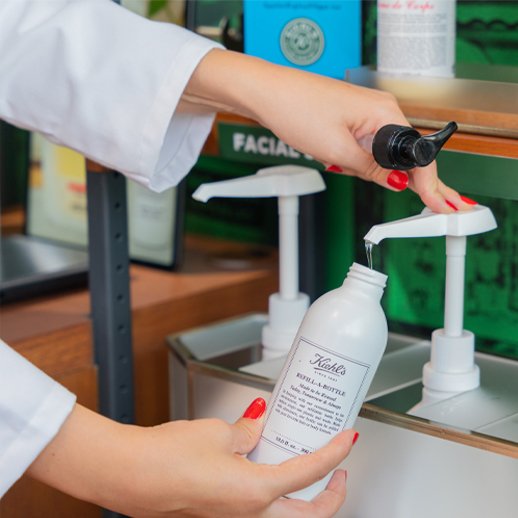A growing number of consumer products companies are experimenting with packaging that can be reused or refilled, but their tests usually start with niche brands. Personal care company Kiehl’s is breaking that mold, offering refillable options for several of its most popular products, including its best-selling Ultra Facial Cream and Ultra Facial Oil-Free Gel Cream.
A half-dozen items comprise the Kiehl’s Refillery program, which gives customers the option to refill in store or to buy pouches to refill existing containers two to three times, depending on the product. In addition to the two facial creams, they include the Creme de Corps body moisturizer, Grapefruit Bath and Shower Liquid Cleanser, Amino Acid Shampoo and Amino Acid Conditioner.
Sales of the refillable packaging, which is offered alongside traditional options. doubled in 2024, and the refill stock keeping units (SKUs) accounted for 16 percent of transactions for the six products, said Maggie Kervick, vice president of sustainability and corporate responsibility for Kiehl’s. The 174-year-old brand, which started in New York’s East Village, was acquired by L’Oreal in 2000.
“I’m not allowed to share specific sales figures,” Kervick said, “but what I can say is that last year we saw a huge acceleration on refills.”
What makes a refillable packaging candidate
The Kiehl’s refill program launched in April 2021 with hair and body products because consumers often buy them in bigger containers before transferring them to smaller ones that fit in a shower or on a vanity top. The company expanded the program to include its best-selling face cream in part to bring scale to the data it collects.
There are three major considerations for Kiehl’s product teams when they ponder a refillable version:
- Whether the ingredients of a particular formula are sensitive to air exposure or have a limited shelf life after they’ve been opened.
- When the product might be updated for other reasons.
- How frequently a product needs to be replenished.
With those things in mind, “We can start to offer a solution knowing that they’re the products that people really want, that are well established and beloved,” Kervick said.

In-home strategy: Refillable pouches
Kiehl’s two-pronged approach features refills completed by associates in the Refillery section of company stores and the sale of products in multi-material, light plastic pouches.
The 150-milliliter facial cream pouch refills the original 50-milliliter jar three times and results in a 61 percent reduction in packaging materials, according to Kervick. Similarly, the shampoo pouch refills the original bottle twice and reduces the product’s plastic footprint by 81 percent.
Any brand offering refill options, though, needs to be flexible with its approach, said Jamie Hall, co-founder and chief customer officer at consulting firm Pentatonic.
“Convenience remains absolutely paramount to either channel,” said Hall, referring to in-store and in-home options. “Both work, and you have to be able to do both, but both will not appeal to all parties.”
Environmental impact: An ‘imperfect’ option
The downside of Kiehl’s current in-home option is that the multi-material makeup of the pouches means they aren’t readily recyclable, rendering them an “imperfect solution,” Hall said. Kiehl’s doesn’t translate plastic reductions into emissions reductions, at least not publicly.
Kiehl’s evaluated and tested many other materials, including a paper-based option, before opting for lightweight plastic. (The main challenge with paper is evaporation for water-intensive products.) In 2026, the company will transition to a monomaterial, plastic film that “will allow them not necessarily to be recycled but to be designed into the system we are all hoping that we will get to,” Kervick said.
Kiehl’s standard format containers contain 38 percent post-consumer recycled content.
The brand is also lightweighting its jars and switching from PET (polyethylene terephthalate) plastic to PP (polypropylene), a move motivated by extended producer responsibility legislation being adopted by states such as California, Oregon and Colorado. “I think we see refills as one of our key levers to help drive things like source reduction,” she said.
That lightweighting process is challenging, because many consumer brands promote hefty packaging as part of their value proposition. “I think the traditional model of weight equals luxury has taken a while to shift,” Hall said, pointing to liquor brands as an example. L’Oreal, for one, is beginning to address packaging intensity across its entire portfolio.
Creating the refill pouches also required Kiehl’s to change how packages are filled; that meant pulling the process into its production rather than having that step handled externally. The company is “working through some of the technical challenges around the filling, making sure it’s a secure process,” Kervick said.
Logistics is one of the biggest obstacles for companies seeking to introduce refill options, said Nicole Smith Ray, senior manager in the climate change and sustainability services practice for EY. “How do you engage the consumer?” she said. “How do you get the right reverse logistics?” Another worry for some brands is losing control of their identity as packaging gets simpler and lighter, she said.
Refills as customer recruitment strategy
Kiehl’s prices its refill pouches so customers wind up with a discount versus what they’d pay for the same amount of product in regular packaging. For example, they pay $70 for the Ultra Facial Cream pouch at retailers such as Sephora, and $117 for jars.
The brand’s team is tracking traditional metrics as it evaluates progress, including sales margin and customer adoption. It’s also closely studying the product mix in different retail settings. Kiehl’s product marketers in South Asia, for example, see refills as a way to engage customers that aren’t active, Kervick said.

